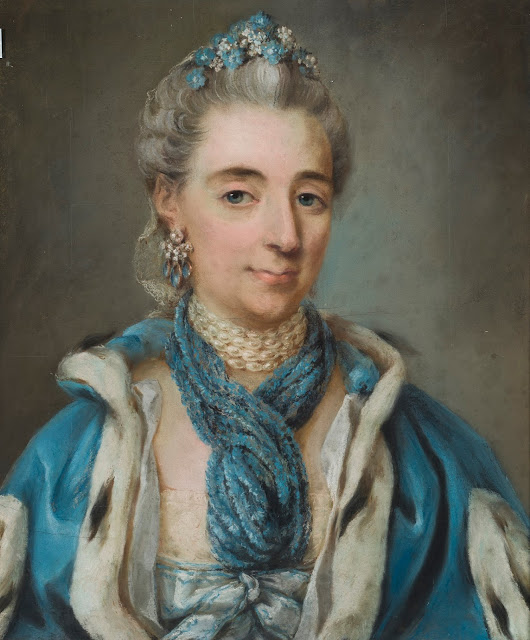 |
| Maurice Quentin de La Tour Portrait of Marie Sophie de Courcillon, Duchesse de Pecquigny, Princesse de Rohan ca. 1740 pastel Nationalmuseum, Stockholm |
 |
| Maurice Quentin de La Tour Portrait study of Voltaire ca. 1740 pastel Nationalmuseum, Stockholm |
 |
| Louis Vigée Portrait of unknown woman in pilgrim costume 1745 pastel Nationalmuseum, Stockholm |
"Pastel differs from natural chalks of different colors, which have long been used in drawing. It is made by mixing powdered pigments with a binder (usually gum arabic), shaping the mixture into sticks, and leaving it to dry. These crayons or sticks of pigment are very crumbly and their colored powder adheres only loosely to paper, which was often roughened in advance to create a surface for the material to cling to. Works in pastel are thus fragile, as movement can loosen the powder."
"Although the earliest works of art to make use of pastel were produced in Renaissance Italy, pastel painting proper dates from the seventeenth century. . . . By the eighteenth century, color, not line, became dominant as pastels moved aesthetically closer to painting. . . . The first artist to be truly internationally renowned for and defined by her pastels was Rosalba Carriera (1673-1757), a Venetian portraitist [below]. . . . Almost 2,500 artists and amateurs were said to be working in pastel in mid-century Paris."
 |
| Rosalba Carriera Young woman with flowers in her hair before 1757 pastel Nationalmuseum, Stockholm |
 |
| Rosalba Carriera Young woman with a wreath of laurels before 1757 pastel Nationalmuseum, Stockholm |
 |
| Gustaf Lundberg Portrait of Count Carl Gustaf Tessin 1761 pastel Nationalmuseum, Stockholm |
 |
| Gustaf Lundberg Portrait of unknown young woman before 1786 pastel Nationalmuseum, Stockholm |
"Pastels have always been praised for the freshness of their colors, at once both brilliant and subtle. Although we now recognize their fragility, in the eighteenth century pastels were often thought more durable than oils, as these vibrant colors were less susceptible to damage by light (oils often faded or yellowed with age). Pastel, too, afforded the artist a richer interplay between medium and support than oils did. Pastel paintings were commonly executed on blue paper mounted on canvas, not only because this was the thickest paper available in the eighteenth century, but also because of the chromatic advantages it offered as the pigments of the pastel picked up and interacted with the blue background."
 |
| Gustaf Lundberg Portrait study of unknown woman before 1786 pastel Nationalmuseum, Stockholm |
 |
| Gustaf Lundberg Portrait of Mrs Petronella Schützer née Psilanderhjelm before 1786 pastel Nationalmuseum, Stockholm |
 |
| Marie-Suzanne Giroust (Madame Roslin) Portrait of Marie-Joseph Peyre 1771 pastel Nationalmuseum, Stockholm |
 |
| Carl Gustav Pilo Portrait of Mrs Ann Katarina Hedenberg née Levin 1793 pastel Nationalmuseum, Stockholm |
"Unlike oils, which can be mixed on a palette from nine or ten basic pigments, each tone requires a different stick of pastel, with artists making use of hundreds of crayons."
– passages quoted from an essay by Francesca Whitlum-Cooper on the Heilbrunn Timeline of Art History from the Metropolitan Museum, New York
 |
| Peder Severin Krøyer Summer evening on the beach at Skagen 1884 pastel Nationalmuseum, Stockholm |
 |
| Anders Zorn Portrait of the artist's wife reading 1889 pastel Nationalmuseum, Stockholm |
 |
| Henri de Toulouse-Lautrec The Rope Dancer before 1901 pastel Nationalmuseum, Stockholm |